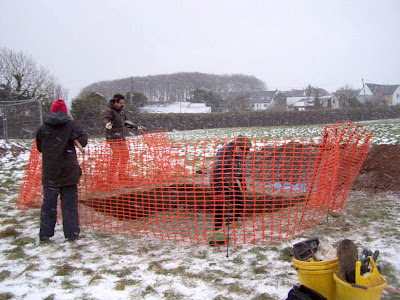Excavations at a newly discovered sixteenth- / seventeenth-century fort at Ballycarry, Co Antrim: Review
[** you like this post, please make a donation to
the IR&DD project using the button at the end. If you think the review is useful,
please re-share via Facebook, Google+, Twitter etc. **]
Preface:
I am very pleased to introduce Duncan Berryman, our latest guest contributor to
the blog. Duncan is a post-graduate student at QUB, and is currently working on
his PhD: ‘A documentary and archaeological investigation of the buildings of
manorial curiae.’ He is currently the editor of the Ulster Archaeological Society’s Newsletter. You may also follow him on Twitter.
Robert M Chapple
Robert M Chapple
 |
| Excavation in progress |
Ballycarry lies a few
miles north of Carrickfergus, Co. Antrim, and occupies an elevated position,
overlooking Larne Lough to the east.
There are many archaeological sites around the village, the largest
being a scheduled enclosure fossilised in field boundaries to the west. A 1970s aerial photograph indicated that the
semicircular enclosure may have once been a complete circle, indicative of an
early Christian monastic enclosure. This
was supported by the presence of Templecorran church to the north of the site,
which was recorded in the papal taxation of 1306-7; the present remains are
mainly sixteenth-century and it fell out of use in the seventeenth century.
Geophysics carried out
to the east of the church in the 1980s proved inconclusive, suggesting there
might be a bank or a change in the underlying bedrock. A bank and ditch were uncovered by
excavations in advance of housing construction, but there was little dating
evidence and a medieval wall was found to overlay the bank. The only pottery found was late medieval and
there was no evidence of early medieval occupation. The excavator believed this was a Neolithic
bank and ditch.
In 2008, the owner of
the land within the scheduled enclosure wished to develop the area for housing. Dearne Valley Archaeological Services Ltd. (DVAS)
was contracted to carry out geophysicical surveys across the enclosure. This survey showed up a number of features
within the fields, but the most interesting was a large square feature with
projections from two of the corners. DVAS
suggested in their report that this feature may have been a tower house. However, as the feature measures 33m by 37m,
the dimensions are simply too great to have been one. It is much closer in style to a sixteenth- or
seventeenth-century artillery fort, such as those illustrated by Richard Bartlett. They were probably constructed from earth and
sod and some were later replaced with stone and lime.
 |
| Ditch visible in Trench 6 |
This leaves the question
of who built the fort.
 |
| Walter Devereux, 1st Earl of Essex. NPG |
The second possible
phase was the Plantation period. There
are no documents relating to the plantation of Ballycarry, as it was planted by
Scottish settlers. But the dimensions of
the fort are approximately right for a Plantation bawn. The land was granted by the O’Neils to John Dalway and was regranted to Dalway, by the King, in 1609. Dalway then granted the land to William
Edmundstone. The Edmundstones took up
residence at Red Hall, north of Ballycarry, which contains the remains of a
tower house. Part of the grant of land
stated that Edmundstone was to build a bawn in the area of Ballycarry. It is possible that William’s brother, James,
may have taken up residence at Ballycarry, while his brother rebuilt the house
at Red Hall. The other possible resident
of a bawn at Ballycarry is Rev Edward Brice, the first Presbyterian minister in
Ireland, who came to Ulster with the Edmundstones and set up a church in the
area. The townland names within the
Templecorran area were changed at the time the Edmundstones acquired the land
around Ballycarry and the townland boundaries may have remained quite fluid
until the nineteenth century.
The third possibility
that it was built a fort during the Confederate Wars of 1641 to 1653. An example of a fort from this period is
Hillsborough Fort. However, most of the
activity in these wars was in southern Ulster and the area around Carrickfergus
was little affected by events in this period.
The Williamite Wars of
the 1680s is the last period that was likely to have seen the construction of
the Ballycarry fort. It is recorded that
Colonel Archibald Edmundstone of Red Hall was involved in the creation of the
‘Council of Five’. The sizable army that
Edmundstone and the Council raised besieged Carrickfergus. Later, they lost a battle known as the ‘Break of Dromore.’ The fort at Ballycarry is
very similar in plan to that at Fortwilliam in Belfast; although, it is
possible that this is from a different period.
Note:
The Data Structure Report (DSR) for the site is available as a downloadable PDF: here.
[** If you like this post, please consider making a small donation. Each donation helps keep the Irish Radiocarbon & Dendrochronological Dates project going! **]
If you’re going to do any shopping through Amazon, please go via the portal below. It costs you nothing, but it will generate a little bit of advertising revenue for this site!



Comments
Post a Comment